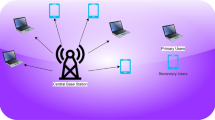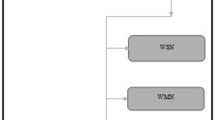Abstract
Military communication involves sharing of secret information which needs to be done with more concern to assure secured transmission of data. In the war field communication would be more difficult task where the soldiers are scattered in different location. In this case route path establishment and routing would be more difficult task due to presence of scattered soldiers in multiple locations. There is various research works has been focused to provide the efficient and better route path establishment in MANET. In the previous work, load and energy aware micro–macro density clustering approach is introduced which focus on performing clustering in two levels micro clustering and macro clustering. However this research work might degrades its clustering performance with respect to energy and time in case of more cluster count generation and also optimal route path construction is also not performed correctly. This is resolved in proposed research work by introducing new framework called multi-objective aware micro–macro clustering using hybridized additive weight based genetic algorithm (MO–MMC–HAWGA). This proposed research work leads to optimal clustering of mobile node under multiple objectives consideration like distance, energy, bandwidth, and stability. Initially it first chooses the optimal cluster head based on which optimal clustering would be done. This work improves the performance by avoiding the more number of clusters which are generated at run time by performing macro clustering. The research work/s experimental evaluation is conducted in NS2 simulation environment and it is proved that proposed research work namely MO–MMC–HAWGA provides optimal result than existing research methods.








Similar content being viewed by others
Change history
30 May 2022
This article has been retracted. Please see the Retraction Notice for more detail: https://doi.org/10.1007/s12652-022-03987-7
References
Abolhasan M, Wysocki T, Dutkiewicz E (2004) A review of routing protocols for mobile ad hoc networks. Ad Hoc Netw 2(1):1–22
Amis AD, Prakash R (2000) Load-balancing clusters in wireless ad hoc networks. In: Proceedings 3rd IEEE symposium on application-specific systems and software engineering technology, pp 25–32
Basu P, Khan N, Little TD (2001) A mobility based metric for clustering in mobile ad hoc networks. In: Proceedings 21st international conference on distributed computing systems workshops, pp 413–418
Belhassen M, Dhraief A, Belghith A, Mathkour H (2018) ALOE: autonomic locating of obstructing entities in MANETs. J Ambient Intell Human Comput 9(3):1955–1974. https://doi.org/10.1007/s12652-018-0742-2
Boukerche A (2008) Algorithms and protocols for wireless and mobile ad hoc networks, vol 77. Wiley, Oxford, pp 1–518
Chatterjee M, Das SK, Turgut D (2000) An on-demand weighted clustering algorithm (WCA) for ad hoc networks. In: Globecom'00-IEEE. global telecommunications conference. Conference Record (Cat. No. 00CH37137), pp 1697–1701
Chen YP, Liestman AL (2002) Approximating minimum size weakly-connected dominating sets for clustering mobile ad hoc networks. In: Proceedings of the 3rd ACM international symposium on mobile ad hoc networking and computing, pp 165–172
Chiang CC, Wu HK, Liu W, Gerla M (1997) Routing in clustered multihop, mobile wireless networks with fading channel. In proceedings of IEEE SICON, 97(1997.4), pp 197–211.
Chlamtac I, Conti M, Liu JJN (2003) Mobile ad hoc networking: imperatives and challenges. Ad Hoc Netw 1(1):13–64
Das B, Bharghavan, V (1997) Routing in ad hoc networks using minimum connected dominating sets. In: Proceedings of IEEE ICC, pp 376–380
Das B, Sivakumar R, Bharghavan V (1997) Routing in ad hoc networks using a spine. In: Proceedings of sixth international conference on computer communications and networks, pp 34–39
Kwon TJ, Gerla M, Varma VK, Barton M, Hsing TR (2003) Efficient flooding with passive clustering-an overhead-free selective forward mechanism for ad hoc/sensor networks. Proc IEEE 91(8):1210–1220
Lin CR, Gerla M (1997) Adaptive clustering for mobile wireless networks. IEEE J Sel Areas Commun 15(7):1265–1275
McDonald AB, Znati TF (1999) A mobility-based framework for adaptive clustering in wireless ad hoc networks. IEEE J Sel Areas Commun 17(8):1466–1487
McDonald AB, Znati TF (2001) Design and performance of a distributed dynamic clustering algorithm for ad-hoc networks. In: IEEE proceedings of 34th annual simulation symposium, pp 27–35
Mueller S, Tsang RP, Ghosal D (2003) Multipath routing in mobile ad hoc networks: issues and challenges. In: International workshop on modeling, analysis, and simulation of computer and telecommunication systems, pp 209–234.
Ohta T, Inoue S, Kakuda Y (2003) An adaptive multihop clustering scheme for highly mobile ad hoc networks. In: The sixth international symposium on autonomous decentralized systems, pp 293–300
Rahmani M, Benchaïba M (2019) PCSM: an efficient multihop proximity aware clustering scheme for mobile peer-to-peer systems. J Ambient Intell Human Comput 10(5):4243–4260. https://doi.org/10.1007/s12652-018-0808-1
Ryu JH, Song S, Cho DH (2001) New clustering schemes for energy conservation in two-tiered mobile ad-hoc networks. In: Proceedings of IEEE ICC’01, pp 862–866
Wu J, Li H (1999) On calculating connected dominating set for efficient routing in ad hoc wireless networks. In: Proceedings of the 3rd international workshop on Discrete algorithms and methods for mobile computing and communications, pp 7–14
Wu J, Dai F, Gao M, Stojmenovic I (2002) On calculating power-aware connected dominating sets for efficient routing in ad hoc wireless networks. J Commun Netw 4(1):59–70
Wu SQ, Ji M, Wang CZ, Nguyen MC, Zhao X, Umemoto K, Ho KM (2013) An adaptive genetic algorithm for crystal structure prediction. J Phys Condens Matter 26(3):1–14
Yu JY, Chong PH (2003) 3hbac (3-hop between adjacent cluster heads): a novel non-overlapping clustering algorithm for mobile ad hoc networks. In: IEEE Pacific rim conference on communications computers and signal processing (PACRIM 2003) (Cat. No. 03CH37490), pp 318–321
Yu JY, Chong PHJ (2005) A survey of clustering schemes for mobile ad hoc networks. IEEE Commun Surv Tutor 7(1):32–48
Author information
Authors and Affiliations
Corresponding author
Additional information
Publisher's Note
Springer Nature remains neutral with regard to jurisdictional claims in published maps and institutional affiliations.
This article has been retracted. Please see the retraction notice for more detail: https://doi.org/10.1007/s12652-022-03987-7"
About this article
Cite this article
Sudhakar, K., Sengottaiyan, N. & Anbukaruppusamy, S. RETRACTED ARTICLE: A hybrid swarm intelligent framework to support efficient military communication in MANET. J Ambient Intell Human Comput 12, 5215–5223 (2021). https://doi.org/10.1007/s12652-020-01999-9
Received:
Accepted:
Published:
Issue Date:
DOI: https://doi.org/10.1007/s12652-020-01999-9




